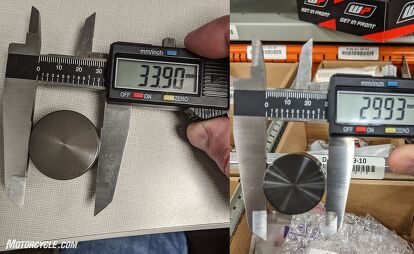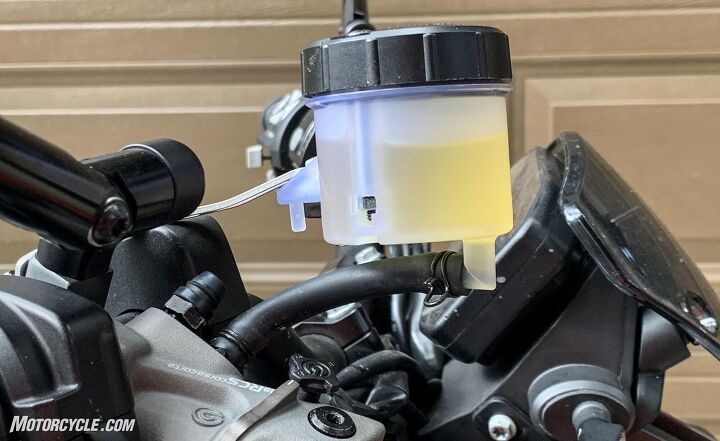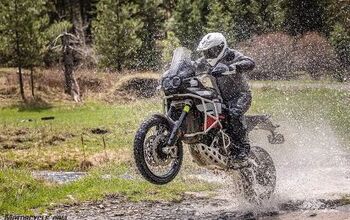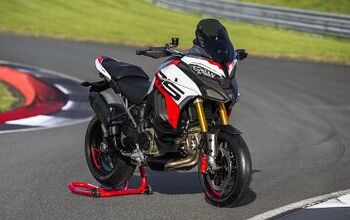MO Tested: Brembo 19 RCS Corsa Corta Master Cylinder

Premium construction and tunability for additional braking control
From the world introduction of the KTM 790 Duke in 2018, detractors have commented on two characteristics of the bike’s front brakes. The first, the soft initial bite from the pads, I easily remedied with the EBC Double-H pads. (KTM PowerParts discs improved the braking even more.) The other characteristic that performance-minded riders expressed their disdain for was the amount of free-play in the lever before the brake was activated. I’m not going to call this a design flaw because I believe it was a deliberate decision on the part of KTM’s engineers. The 790 Duke was designed to be a street bike, and that little bit of free play can help less experienced riders avoid initial abruptness with their brake application – which is a good thing, particularly in a panic stop situation.
Performance-focused riders, however, have a different set of priorities. This is why premium braking components like the Brembo RCS 17/19 Corsa Corta master cylinder exist – to give expert riders the tools they need. Additionally, Brembo’s master cylinder technology has advanced beyond being simply more powerful and now gives riders the capability to tune both the lever free play and the power delivery to suit their braking preferences.
About Master Cylinders
Before we dive into the specifics of the Corsa Cortas, we need to take a look at two important qualities of a master cylinder. Radial master cylinders are all the rage – and the reasoning behind them is sound. In a radial master cylinder, the lever travels in the same direction as the piston. With axial master cylinders, the design of the lever assembly has the piston traveling at a right angle to the motion of the lever. This limits lever feel because the lever actuates the piston via a fulcrum and may even need to slide slightly across the top of the piston itself. Not exactly ideal for delivering braking feel to the rider. Since a radial brake lever and piston operate in the same direction, friction is reduced, the need for a pivot is negated, and the feedback accomplished riders are looking for has a more direct path to their fingers.
Radial master cylinders are categorized in two more ways. The first is by piston diameter, which accounts for the volume of brake fluid moved when the rider squeezes the lever. When choosing the correct piston diameter for an aftermarket master cylinder, bigger isn’t always better. Go too big with the piston, and the excess hydraulic fluid flow will lead to abrupt braking and lessened lever feel. Choose too small a diameter, and the lever will feel mushy as the additional pressure required to achieve maximum braking is applied. Consequently, other factors, like the number and size of the calipers’ pistons, need to be considered for master cylinder sizing.
Piston offset from the lever’s pivot point is the second way that master cylinders are categorized. When you see a radial master cylinder listed as a 19 x 18, it is saying that the piston diameter is 19mm with an offset of 18mm. The further the offset of the piston, the more leverage there is on the piston, and the firmer the action of the lever is. However, things have advanced beyond fixed offsets. The Brembo RCS (Ratio Control System) offers adjustable offset as a means of tuning the lever ratio.
Typically, with the Brembo RCS Corsa Corta master cylinders, like the ones tested here, the choices of offset are 18mm and 20mm. While these two offsets provide the same maximum pressure output from the master cylinder, the character of the brake application changes when switching between the two. In the RCS, the offset is changed via a small screwdriver and a rotating cam. With the cam in the 20mm position, the onset of the brake pressure is more aggressive, but this quickness comes at the expense of lever feel. In the 18mm position, the braking power distribution favors feel for more precise modulation. A popular misconception states that the 20mm position delivers more power to the lever. Most likely, this stems from the sharp initial bite of the brakes in this position while the 18mm setting delivers a more supple feel. According to Brembo, both settings deliver the same braking power.
The new feature that sets the Corsa Corta apart from previous Brembo RCS master cylinders is the ability to alter the lever free play before the braking actually takes effect. Brembo gives three options N (normal), S (sport), and R (race) with each setting giving progressively less lever movement before the initial pad bite point. This allows the rider to tune the brake application to personal preferences or to suit the riding environment. For example, using N for rainy weather where a deft touch is required and R for a track day in which immediacy is paramount.
If you’ve been paying attention, you’re probably wondering why I would change the master cylinder at all, since the J.Juan unit on the 790 Duke has a radial piston, and as a result, delivers the benefits of the configuration. Aside from the adjustability that the Brembo RCS Corsa Corta offers, there is the premium construction to consider. The Brembo master cylinder is forged, meaning its metal is heated to just shy of melting and then stamped into its current shape. All internal plumbing is precision machined, and the exterior is hard anodized for durability. The tighter tolerances pay off in better feel at the lever. OEM components, particularly those of a motorcycle built to a price, simply aren’t produced to the same specifications since the process is more expensive. For sake of comparison, a complete replacement OEM master cylinder retails for $208, and the Brembo RCS Corsa Corta costs $372 (plus $58 for the reservoir kit). So, my goals for replacing the J.Juan master cylinder with the Brembo unit were to gain adjustability, braking power, and improved feel.
Non-OEM Components
When mounting a master cylinder that is not made specifically for your model motorcycle, you may run into challenges that need to be addressed. For example, the KTM brake line has a 90-degree bend in the banjo, requiring an adapter. Fortunately, AF1 Racing has a Radial Master Cylinder Kit available for $35. This not only solved my banjo orientation issues, but also gave me a little more reach with the brake line to accommodate the location of the master cylinder. My second challenge was getting the bend in the brake lever to have enough clearance with the throttle housing. I remedied this by mounting the master cylinder between the throttle housing and the engine cut off/starter switch. The resulting set up is not as visually clean as the stock location of the master cylinder mount and switchgear, but it gives the lever the clearance it needs.
The other challenge I faced with the installation of the 17RCS was bleeding the brake system. While possibly not directly related to the master cylinder itself, I have never struggled to get a firm lever on any bike as much as I did on this motorcycle. It could be the ABS or the odd high point in the lines where they attach to the bottom of the triple clamp. Regardless of the cause, I pumped three cans of Motorex 5.1 brake fluid through the system before I was able to get a firm lever. However, even after this, the lever 17 RCS was never as firm as I expected it to be. (For comparison, the R6 and the ZX-6R that we have in our possession both have significantly firmer levers.)
In my research on this issue, I made a surprising discovery. While I thought the Brembo master cylinder had an equal or larger piston to the J.Juan one, I was wrong. The stock piston is 18mm, and the Brembo one is 17mm. Brembo’s website recommends that the 17 RCS be paired with calipers with four 30mm pistons. The J.Juan calipers on the 790 have two 30mm pistons and two 34mm pistons, averaging 32mm, which is larger than Brembo recommends. So, suspecting that this may be the cause of my soft lever, I arranged to get a 19 RCS to see if it worked better for me.
After I installed the 19 RCS and bled the lines – yet again – I finally experienced the firmness I desired from the lever.
Street and Track Use
My experience riding on the street with the Brembo 17 RCS Corsa Corta was that of being able to dial in the exact amount of brake pressure I wanted. Although the lever was softer than I like, the sensation of trail braking was markedly different from stock. I really like that Corsa Corta master cylinders have the ability to dial out the slack in the initial application of the brakes. Over time, it became clear to me that the minimal free play that is offered by the R setting was my favorite both on the street and the track with the 17 RCS.
The 17 RCS’ braking power is remarkably linear. Although it was able to deliver the power necessary to haul the bike down from speed in maximum braking scenarios, I was always bothered by the softness of the lever. Consequently, I kept the piston offset of the 17 RCS at 20mm for the most firmness that it offered. Moving it to the 18mm position made the lever feel downright mushy.
With the 19 RCS installed, I immediately felt the braking power improvement I had been craving. Even before I got to the freeway to head to my favorite mountain testing route, I knew the 19mm piston was, for my tastes, the hot setup on the 790 Duke with J.Juan calipers. The rest of the ride in the canyons only solidified my opinion. The initial application of the front brake comes on much stronger, though not abruptly, and with the free play set to R, lever action is almost immediate. While the feel isn’t as great as with the 17 RCS, the sensations at the lever are still better than that of the OEM setup. After playing around with the offset settings, I settled on the 20mm position for its strong response. This came as a surprise to me because I’m typically a finesse over brute force kinda rider.
The true test of braking components, naturally, is on a closed course where they can be used at their limits in a controlled environment. My desire for better track day braking performance was the instigator of this project, and it was on the track that I wanted to truly experience the Brembo 19 RCS Corsa Corta’s capabilities. Unfortunately, the weather gods and COVID-19 conspired against me, and Let’s Ride Trackdays did the unheard of: They canceled their event, a commendable decision given the viral onslaught we’re facing. So, rather than wait another month for the next track day before posting this article, it’s going up now. Once I have the opportunity to use the master cylinder at the track, I’ll update the review.
The Finish Line
With the saga of the correctly-sized master cylinder resolved to my satisfaction, my conclusions are: Do some research about your particular motorcycle before pulling the trigger. If I had known the size of the J.Juan calipers’ pistons before my first order, I could have saved myself a lot of trouble. However, there is still a place for the 17 RCS Corsa Corta on the 790 Duke. If you’re planning on installing Brembo M50 or Stylema calipers, you’ll want to go with the 17 RCS. However, if you’re like me and are keeping the OEM calipers, the Brembo 19 RCS Corsa Corta is the correct master cylinder. As much as the moto-geek in me says to go with the M50s, I’m extremely happy with the 19 RCS and how it improves my braking experience on my 790 Duke. I consider it to be money well spent. The final out of pocket cost is $505 for:
- master cylinder, $372
- remote reservoir, $58
- bar clamp with mirror mount, $40
- radial master cylinder kit, $35.
If you’re looking for more out of your front brake, the correctly-sized Brembo RCS Corsa Corta is a great place to find it.
Shop for the Brembo 19 RCS Corsa Corta here
We are committed to finding, researching, and recommending the best products. We earn commissions from purchases you make using the retail links in our product reviews. Learn more about how this works.

Like most of the best happenings in his life, Evans stumbled into his motojournalism career. While on his way to a planned life in academia, he applied for a job at a motorcycle magazine, thinking he’d get the opportunity to write some freelance articles. Instead, he was offered a full-time job in which he discovered he could actually get paid to ride other people’s motorcycles – and he’s never looked back. Over the 25 years he’s been in the motorcycle industry, Evans has written two books, 101 Sportbike Performance Projects and How to Modify Your Metric Cruiser, and has ridden just about every production motorcycle manufactured. Evans has a deep love of motorcycles and believes they are a force for good in the world.
More by Evans Brasfield












































Comments
Join the conversation
Thank you for the explainer on radial master cylinder architecture. I knew it is better, but I didn't really understand why.
hello, and what you think about hc1 m/c with 18 mm piston diameter?? its just between 17 and 19 rcs??? that could be work??
best regards